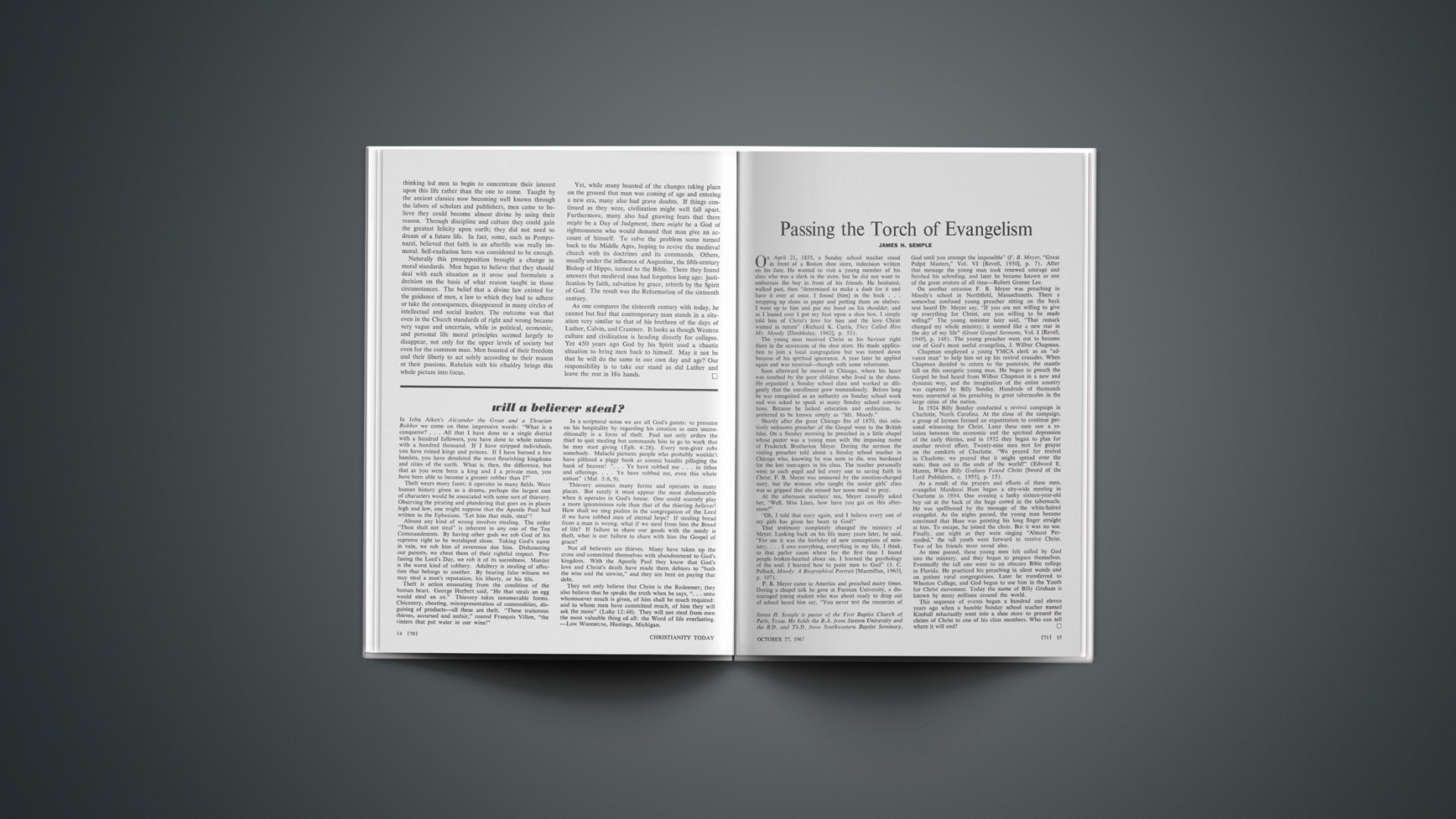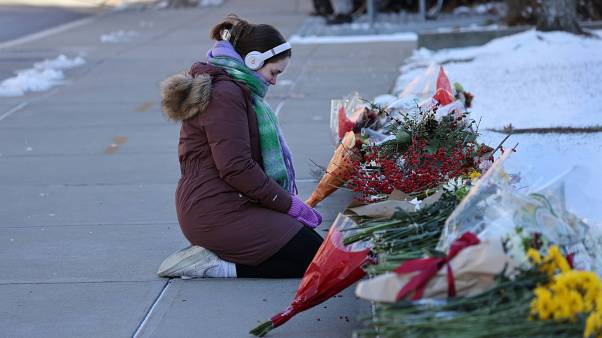On April 21, 1855, a Sunday school teacher stood in front of a Boston shoe store, indecision written on his face. He wanted to visit a young member of his class who was a clerk in the store, but he did not want to embarrass the boy in front of his friends. He hesitated, walked past, then “determined to make a dash for it and have it over at once. I found [him] in the back … wrapping up shoes in paper and putting them on shelves. I went up to him and put my hand on his shoulder, and as I leaned over I put my foot upon a shoe box. I simply told him of Christ’s love for him and the love Christ wanted in return” (Richard K. Curtis, They Called Him Mr. Moody [Doubleday, 1962], p. 53).
The young man received Christ as his Saviour right there in the storeroom of the shoe store. He made application to join a local congregation but was turned down because of his spiritual ignorance. A year later he applied again and was received—though with some reluctance.
Soon afterward he moved to Chicago, where his heart was touched by the poor children who lived in the slums. He organized a Sunday school class and worked so diligently that the enrollment grew tremendously. Before long he was recognized as an authority on Sunday school work and was asked to speak at many Sunday school conventions. Because he lacked education and ordination, he preferred to be known simply as “Mr. Moody.”
Shortly after the great Chicago fire of 1870, this relatively unknown preacher of the Gospel went to the British Isles. On a Sunday morning he preached in a little chapel whose pastor was a young man with the imposing name of Frederick Brotherton Meyer. During the sermon the visiting preacher told about a Sunday school teacher in Chicago who, knowing he was soon to die, was burdened for the lost teen-agers in his class. The teacher personally went to each pupil and led every one to saving faith in Christ. F. B. Meyer was unmoved by the emotion-charged story, but the woman who taught the senior girls’ class was so gripped that she missed her noon meal to pray.
At the afternoon teachers’ tea, Meyer casually asked her, “Well, Miss Lines, how have you got on this afternoon?”
“Oh, I told that story again, and I believe every one of my girls has given her heart to God!”
That testimony completely changed the ministry of Meyer. Looking back on his life many years later, he said, “For me it was the birthday of new conceptions of ministry.… I owe everything, everything in my life, I think, to that parlor room where for the first time I found people broken-hearted about sin. I learned the psychology of the soul. I learned how to point men to God” (J. C. Pollock, Moody: A Biographical Portrait [Macmillan, 1963], p. 107).
F. B. Meyer came to America and preached many times. During a chapel talk he gave at Furman University, a discouraged young student who was about ready to drop out of school heard him say, “You never test the resources of God until you attempt the impossible” (F. B. Meyer, “Great Pulpit Masters,” Vol. VI [Revell, 1950], p. 7). After that message the young man took renewed courage and finished his schooling, and later he became known as one of the great orators of all time—Robert Greene Lee.
On another occasion F. B. Meyer was preaching in Moody’s school in Northfield, Massachusetts. There a somewhat confused young preacher sitting on the back seat heard Dr. Meyer say, “If you are not willing to give up everything for Christ, are you willing to be made willing?” The young minister later said, “That remark changed my whole ministry; it seemed like a new star in the sky of my life” (Great Gospel Sermons, Vol. I [Revell, 1949], p. 148). The young preacher went out to become one of God’s most useful evangelists, J. Wilbur Chapman.
Chapman employed a young YMCA clerk as an “advance man” to help him set up his revival crusades. When Chapman decided to return to the pastorate, the mantle fell on this energetic young man. He began to preach the Gospel he had heard from Wilbur Chapman in a new and dynamic way, and the imagination of the entire country was captured by Billy Sunday. Hundreds of thousands were converted at his preaching in great tabernacles in the large cities of the nation.
In 1924 Billy Sunday conducted a revival campaign in Charlotte, North Carolina. At the close of the campaign, a group of laymen formed an organization to continue personal witnessing for Christ. Later these men saw a relation between the economic and the spiritual depression of the early thirties, and in 1932 they began to plan for another revival effort. Twenty-nine men met for prayer on the outskirts of Charlotte. “We prayed for revival in Charlotte; we prayed that it might spread over the state; then out to the ends of the world!” (Edward E. Hamm, When Billy Graham Found Christ [Sword of the Lord Publishers, c. 1955], p. 15).
As a result of the prayers and efforts of these men, evangelist Mordecai Ham began a city-wide meeting in Charlotte in 1934. One evening a lanky sixteen-year-old boy sat at the back of the huge crowd in the tabernacle. He was spellbound by the message of the white-haired evangelist. As the nights passed, the young man became convinced that Ham was pointing his long finger straight at him. To escape, he joined the choir. But it was no use. Finally, one night as they were singing “Almost Persuaded,” the tall youth went forward to receive Christ. Two of his friends were saved also.
As time passed, these young men felt called by God into the ministry, and they began to prepare themselves. Eventually the tall one went to an obscure Bible college in Florida. He practiced his preaching in silent woods and on patient rural congregations. Later he transferred to Wheaton College, and God began to use him in the Youth for Christ movement. Today the name of Billy Graham is known by many millions around the world.
This sequence of events began a hundred and eleven years ago when a humble Sunday school teacher named Kimball reluctantly went into a shoe store to present the claims of Christ to one of his class members. Who can tell where it will end?
Milton D. Hunnex is professor and head of the department of philosophy at Willamette University, Salem, Oregon. He received the B.A. and M.A. degrees from the University of Redlands and the Ph.D. in the Inter-collegiate Program in Graduate Studies, Claremont, California. He is author of “Philosophies and Philosophers.”









